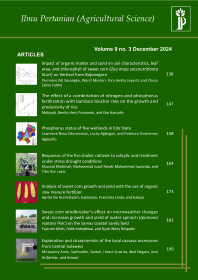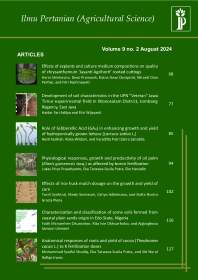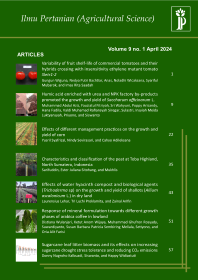Shallot Growth and Yields Based on Ammonium:Nitrate Ratio on Coastal Sandy Soil
Wiji Safitri(1*), Endang Sulistyaningsih(2), Benito Heru Purwanto(3), Stephen Harper(4)
(1) Department of Agronomy, Faculty of Agriculture, Universitas Gadjah Mada
(2) Department of Agronomy, Faculty of Agriculture, Universitas Gadjah Mada
(3) Department of Soil Science Faculty of Agriculture, Universitas Gadjah Mada
(4) Australian Centre for International Agricultural Research
(*) Corresponding Author
Abstract
Keywords
Full Text:
PDFReferences
Aryani, N. 2016. Pengaruh Pemberian Vermikompos dan Pupuk Pelengkap terhadap Produksi Tanaman Bawang Merah Tuk – Tuk (Allium ascalonicum L.) dan Beberapa Sifat Kimia Tanah Ultisol. Skripsi. Fakultas Pertanian Universitas Lampung.
Barker, A.V. and H.A. Mills. 1980. Ammonium and Nitrate Nutrition of Horticultural Crops. Hort.Rev., 2: 395-423.
Errebhi, M., and G. E. Wilcox. 1990. Plant Species Response to Ammonium-Nitrate Concentration Ratios. Journal of Plant Nutrition, 13(8): 1017-1029.
Firmansyah, I. and N. Sumarni. 2013. Effect of N Fertilizer Dosages and Varieties On Soil pH, Soil Total-N, N Uptake, and Yield of Shallots (Allium ascalonicum L.) Varieties On Entisols - Brebes Central Java. Bandung Barat: Balai Penelitian Tanaman Sayuran.
Gamiely, S., W. M. Randle, H. A. Mills, and D.A. Smittle. 1991. Onion Plant Growth, Bulb Quality, and Water Uptake Following Ammonium and Nitrate Nutrition. HORTSCIENCE, 26(8): 1061-1063.
Giyanto, A. 2014. Pengaruh Faktor Suhu terhadap Pertumbuhan Tanaman. Indralaya: Universitas Sriwijaya.
Hatfield, J. L. and J. H. Prueger. 2015. Temperature Extreme : Effect on Plant Growth and Development. Water and Climate Extremes, 10(A): 4-10.
Koheri, A., Mariati, dan T. Simanungkalit. 2015. Tanggap Pertumbuhan dan Produksi Bawang Merah (Allium ascalonicum, L.) terhadap Waktu Aplikasi dan Konsentrasi Pupuk KNO3. Jurnal Online Agroekoteknologi, 3 (1): 206-213.
Lafta, A. M. and J. H. Lorenzen. 1995. Effect of High Temperature on Plant Growth and Carbohydrate Metabolism in Potato. Plant Physiol, 109: 637-643.
Nori, M., J. Aali, and R. ShafiriAsl. 2012. Effect of Different Sources and Levels of Nitrogen Fertilizer on Yield and Nitrate Accumulation in Garlic (Allium sativum L.). Intl J Agri Crop Sci., 4 (24): 1878-1880.
Sas, L., H. Marscher, V. Romheld, and S. Mercik. 2003. Effect of Nitrogen Forms on Growth and Chemical Changes in Rhizosphere of Strawberry Plants. ACTA PHYSIOLOGIAE PLANTARUM, 25 (3): 241-247.
Sumarni, N. dan A. Hidayat. 2005. Budidaya Bawang Merah. Bandung: Balai Penelitian Tanaman Sayuran.
Sumarni, N., R. Rosliani, dan R. S. Basuki. 2012. Respon Pertumbuhan, Hasil Umbi, dan Serapan Hara NPK Tanaman Bawang Merah Terhadap Berbagai Dosis Pemupukan NPK pada Tanah Alluvial. J. Hort., 22(4): 366-375.
Sugiyarto, M., dan J. Ginting. 2013. Respon Pertumbuhan dan Produksi Beberapa Kultivar Bawang Merah (Allium ascalonisum L.) terhadap Berbagai Sumber Nitrogen Organik. Jurnal Online Agroekoteknologi, 2 (1): 402-410.
Wiren, N. V., A. Gojon, S. Chaillou, and D. Raper Jr. 2001. Mechanism and Regulation of Ammonium Uptake in Higher Plants. In: P. J. Lea et al. (eds.), Plant Nitrogen. Berlin Heidelberg: Springer-Verlag, pp. 61-77.
Woldetsadik, K., U. Gertsson, and J. Ascard. 2003. Response of Shallot to Mulching and Nitrogen Fertilization. HortScience, 38(2): 217-221.
Article Metrics
Refbacks
- There are currently no refbacks.
Ilmu Pertanian (Agricultural Science) ISSN 0126-4214 (print), ISSN 2527-7162 (online) is published by Faculty of Agriculture Universitas Gadjah Mada collaboration with Perhimpunan Sarjana Pertanian Indonesia (PISPI) and licensed under a Creative Commons Attribution-ShareAlike 4.0 International License.













